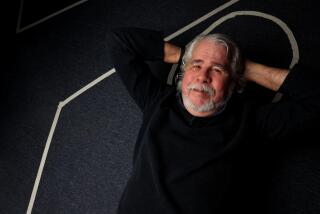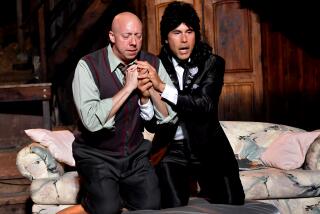STAGE REVIEWS: VARIATIONS ON A RITE OF PASSAGE : Young Rebel Goes Out on a Limb to Get the Story Across in Calvino’s ‘Baron in the Trees’
If you know some people who have never witnessed a real play in action and might be wondering what all this theater stuff is about, take them to the Ensemble Studio Theatre’s new production of “The Baron in the Trees.”
This is the kind of show that can turn people on to the art form for life--especially young people, and despite the fact that this is “The Baron in the Trees” by Italo Calvino, one of the century’s most resourceful but densest and most complex of fictionists. Director Stephen Sachs has not only adapted Calvino’s Candide-like tale with an acute ear for both economy and theatrical effect, but has also chosen one of Calvino’s most direct, least baroque inventions.
For it is invention that’s the watchword here, from the ingenious, suggestive world created out of ropes, ladders, benches, stools and the simplest of lighting (J. Kent Inasy) and musical (Nicholas Kirgo) effects, to the 13-member ensemble swimming in and out of roles (over 70 speaking parts in all) with the grace of dolphins on the high seas.
The style here is story theater, so seldom employed that it may seem new to some viewers. Paul Sills and his gifted company worked similar magic with his “Story Theatre” some 17 years ago. But for ambition, a sense of child’s play and deep ideas (when was the last time you saw that combination?), I’ll take Sachs et al.
The baron in the trees is one Cosimo Piovasco di Rondo (Tuck Milligan). He rebels against his social-climbing parents, who drive him up into the branches after he refuses to eat a plate of snails.
Only 12, he’s really a rebel without a cause--an Age of Reason version of Tom Sawyer and Huck Finn. Milligan, with his winning, boyish eloquence, plus the fact that he played Huck in “Big River” at La Jolla Playhouse a few seasons back, reinforces that feeling.
“I’ll never come down again!” Cosimo screams at his family. His younger brother, Biagio (Jeff Doucette), our faithful narrator and more than a little envious of his big brother’s revolution, adds, “And he kept his word.” This removes the story from the stickiness of the bittersweet and places it in the richer world of lights and shadows--again, like Twain’s “Huckleberry Finn.” (Cosimo’s father, an effective Charles Marks, barks at him: “Do you intend to grow up like an American savage?”)
What’s also informing this novelistic fable is the spirit of revolt that galvanized Cosimo’s age: He becomes known as a follower of Voltaire, he jots down drafts for a constitution of civil rights for every--and he means every--living thing, and he witnesses the French Revolution, from afar.
The irony of Calvino’s narrative, especially as Sachs stages it, is that Cosimo remains distant from spectacles of political freedom while witnessing close-up the savagery of the Napoleonic Wars (as soldiers die, a small red ribbon shoots from their chests).
“The Baron in the Trees” is an epic of great sadness, performed with the joyous sense of pure play.
Few women cross Cosimo’s path--how could they?--and in a perfect image, Sachs has a lonely Milligan yelping like a cat in heat up in the trees, a silvery crescent moon above him. The show is crammed with such beauty, humor and pathos, as if these qualities were all about to expire.
As Milligan, gradually growing old and bitter, is up there on his ladders and Doucette gently spins the tale from below, such unforgettable characters emerge as Cosimo’s love, Viola (Theresa Karanik); her dog Buffa (Lisa Cloud, who seems born for story theater); a friendly Abbe and the bookish thief Gian dei Brughi (both played by Chris Hendrie); the leader of a group of Spaniards exiled to the trees and an outrageous Voltaire (both by Marks).
Instant, fantastic types. And when the actors aren’t breaking new records as quick-change artists, they are just off the platform stage, miming flowers and making atmospheric bird calls. Even if Sachs had to settle for a garage in which to do his play, we would still feel arbor-bound.
Part of the reason is that Sachs’ company stuck together to work on “Baron” for a year, developing the kind of second nature about story theater’s intuitive and improvisatory manner that acrobat families do in their field. It’s hard to imagine any understudies for this ensemble. In this city of transient actors, “The Baron in the Trees” is testimony to the power of residency.
Performances at 1089 N. Oxford St. run Wednesdays through Saturdays, 8 p.m.; Sundays, 3 p.m. Ends Aug. 2. Tickets: $5-12; (213) 466-2916.
More to Read
The biggest entertainment stories
Get our big stories about Hollywood, film, television, music, arts, culture and more right in your inbox as soon as they publish.
You may occasionally receive promotional content from the Los Angeles Times.










